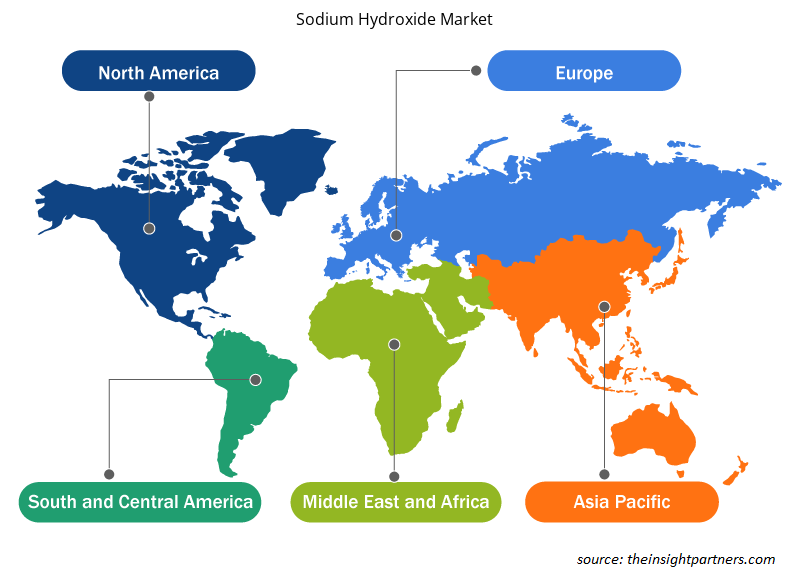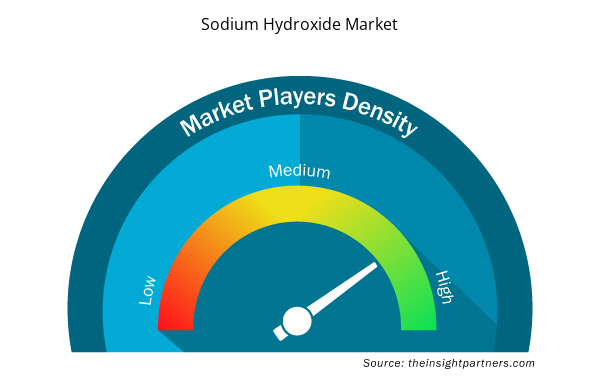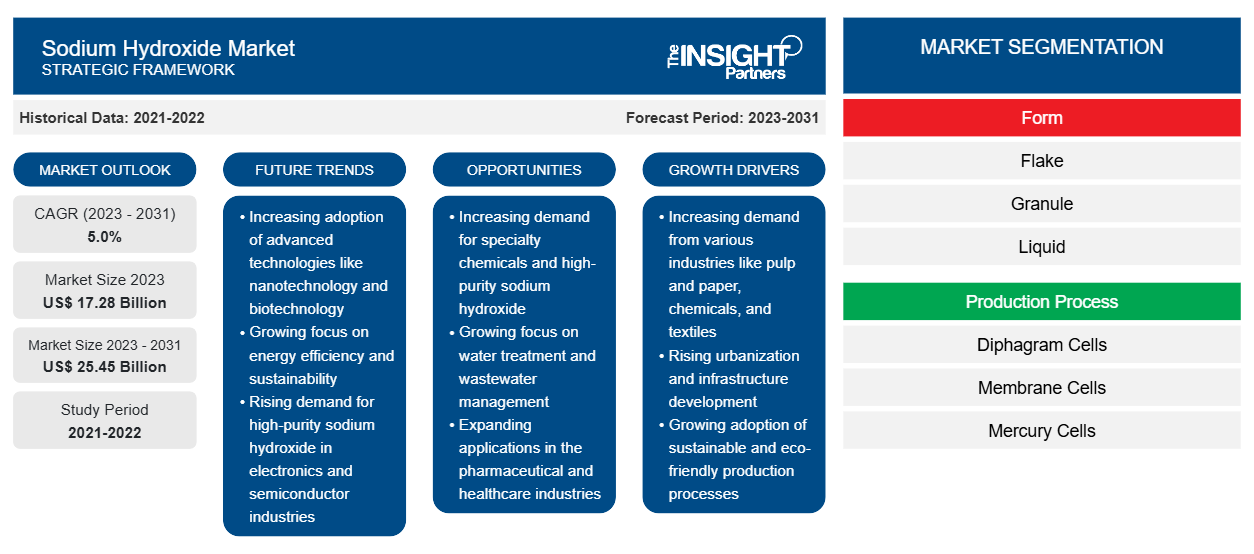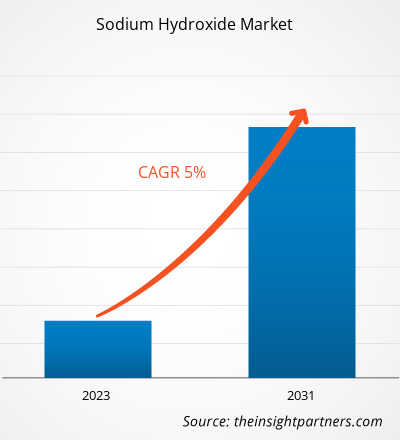من المتوقع أن يصل حجم سوق هيدروكسيد الصوديوم إلى 25.45 مليار دولار أمريكي بحلول عام 2031 من 17.28 مليار دولار أمريكي في عام 2023. ومن المتوقع أن يسجل السوق معدل نمو سنوي مركب بنسبة 5.0٪ في الفترة 2023-2031. ومن المرجح أن يظل الطلب المتزايد من الصناعات ذات الاستخدام النهائي، بما في ذلك اللب والورق والعناية الشخصية والأدوية ومعالجة المياه، اتجاهًا رئيسيًا في سوق هيدروكسيد الصوديوم.
تحليل سوق هيدروكسيد الصوديوم
في صناعة الأغذية، يستخدم هيدروكسيد الصوديوم في معالجة الأغذية، كمنظم لدرجة الحموضة، وفي تحضير بعض المنتجات مثل الزيتون والبريتزل. في صناعة العناية الشخصية، يستخدم هيدروكسيد الصوديوم في تصنيع الصابون. هيدروكسيد الصوديوم هو عنصر حيوي في عملية التصبين. في هذه العملية، يتفاعل هيدروكسيد الصوديوم مع الزيوت الطبيعية أو الدهون، مثل جوز الهند أو زيت الزيتون، لتكوين الصابون. يحول هذا التفاعل هذه الزيوت إلى قطع صابون أو صابون سائل. يساعد هيدروكسيد الصوديوم أيضًا في ضبط مستويات الرقم الهيدروجيني. يؤكد هيدروكسيد الصوديوم أيضًا أن المنتج النهائي آمن للاستخدام على الجلد مع خصائص تنظيف فعالة. بالإضافة إلى ذلك، يستخدم هيدروكسيد الصوديوم لتصنيع منتجات العناية بالشعر المختلفة. كما يستخدم في تصنيع منتجات التجعيد، ومستحضرات فرد الشعر، ومنتجات فرد الشعر . يساعد هيدروكسيد الصوديوم في كسر روابط ثاني كبريتيد في الشعر. يساعد هذا في إعادة تشكيل أو إعادة هيكلة ألياف الشعر. هذه العملية ضرورية لتحقيق تسريحات الشعر المرغوبة. إن الشعبية المتزايدة لمنتجات تصفيف الشعر المختلفة ومنتجات العناية الشخصية الأخرى هي التي تدفع الطلب على هيدروكسيد الصوديوم في عملية تصنيع هذه المنتجات.
نظرة عامة على سوق هيدروكسيد الصوديوم
يستخدم هيدروكسيد الصوديوم على نطاق واسع في إنتاج البوليمرات. البولي كربونات هو مادة ترموبلاستيكية معروفة بوضوحها البصري ومقاومتها للصدمات ويتم إنتاجها باستخدام هيدروكسيد الصوديوم في البلمرة. في هذا الإنتاج، يتم استخدام هيدروكسيد الصوديوم كمحفز لتسريع التفاعل بين البيسفينول أ والفوسجين، وتشكيل سلاسل البولي كربونات . والنتيجة هي مادة متعددة الاستخدامات تستخدم في العديد من الصناعات، بما في ذلك صناعة السيارات والبصريات والإلكترونيات. علاوة على ذلك، يستخدم هيدروكسيد الصوديوم أيضًا في أكسيد البولي بروبيلين (PPO)، حيث يعمل كمحفز في عملية البلمرة، ويشكل سلسلة PPO من مونومرات أكسيد البروبيلين. يتم استخدام البوليمر الناتج في تطبيقات متخصصة مختلفة وله مقاومة كيميائية استثنائية، مما يدفع نمو سوق هيدروكسيد الصوديوم.
قم بتخصيص هذا التقرير ليناسب متطلباتك
ستحصل على تخصيص لأي تقرير - مجانًا - بما في ذلك أجزاء من هذا التقرير، أو تحليل على مستوى الدولة، وحزمة بيانات Excel، بالإضافة إلى الاستفادة من العروض والخصومات الرائعة للشركات الناشئة والجامعات
- احصل على أهم اتجاهات السوق الرئيسية لهذا التقرير.ستتضمن هذه العينة المجانية تحليلاً للبيانات، بدءًا من اتجاهات السوق وحتى التقديرات والتوقعات.
محركات وفرص سوق هيدروكسيد الصوديوم
الطلب المتزايد من صناعة المنسوجات يعزز نمو سوق هيدروكسيد الصوديوم
صناعة النسيج هي قطاع تطبيقي مهم لسوق هيدروكسيد الصوديوم. في صناعة النسيج، يتم استخدامه في عملية المرسرة. المرسرة هي عملية معالجة تستخدم على الألياف السليلوزية، مثل القطن، لتعزيز خصائصها. في هذه العملية، يتم معالجة ألياف القطن بمحلول NaOH، مما يتسبب في انتفاخ الألياف، مما يؤدي إلى زيادة اللمعان والقوة وامتصاص الصبغة. تعمل المرسرة على تحسين جودة ومظهر المنسوجات القطنية بشكل عام، مما يجعلها أكثر نعومة وأكثر استجابة للأصباغ والتشطيبات.
تزايد الاعتماد من قبل صناعة الأدوية
في صناعة الأدوية، يعمل ككاشف حاسم في تركيب المركبات الصيدلانية. يتم استخدامه في مراحل مختلفة من إنتاج الأدوية، بما في ذلك تركيب المكونات الصيدلانية النشطة (APIs) وصياغة المنتجات الدوائية. في تركيب API، يتم استخدامه لضبط مستويات الرقم الهيدروجيني، وتسهيل التفاعلات الكيميائية، أو التحكم في قابلية ذوبان مكونات دوائية معينة. يساعد استخدامه الدقيق في ضمان فعالية وسلامة المنتجات الصيدلانية، مما يؤدي إلى زيادة نمو سوق هيدروكسيد الصوديوم.
تقرير تحليل تجزئة سوق هيدروكسيد الصوديوم
إن القطاعات الرئيسية التي ساهمت في اشتقاق تحليل سوق هيدروكسيد الصوديوم هي الشكل وعملية الإنتاج والصناعة النهائية.
- بناءً على الشكل، ينقسم السوق إلى رقائق وحبيبات وسائل. احتلت شريحة السوائل حصة سوقية أكبر في عام 2023.
- من حيث عملية الإنتاج، يتم تقسيم السوق إلى خلايا ثنائية الترابط وخلايا غشائية وخلايا زئبقية. احتل قطاع الخلايا الغشائية الحصة الأكبر من السوق في عام 2023.
- على أساس صناعة الاستخدام النهائي، يتم تقسيم السوق إلى اللب والورق، والعناية الشخصية، والأدوية، ومعالجة المياه، والمنسوجات، والأغذية، وغيرها. احتل قطاع اللب والورق الحصة الأكبر من السوق في عام 2023.
تحليل حصة سوق هيدروكسيد الصوديوم حسب المنطقة الجغرافية
ينقسم النطاق الجغرافي لتقرير سوق هيدروكسيد الصوديوم بشكل أساسي إلى خمس مناطق: أمريكا الشمالية، ومنطقة آسيا والمحيط الهادئ، وأوروبا، والشرق الأوسط وأفريقيا، وأمريكا الجنوبية والوسطى.
أصبحت منطقة آسيا والمحيط الهادئ مركزًا عالميًا للتصنيع، حيث تضم صناعات تشمل الكيماويات والمنسوجات واللب والورق. وشهدت منطقة آسيا والمحيط الهادئ التصنيع والتحضر السريع. وتعتمد العديد من العمليات الكيميائية، مثل إنتاج البلاستيك والمنظفات والمواد الكيميائية الصناعية المختلفة، على هذه المادة الكيميائية كمادة خام أساسية. ومع الحضور القوي لمنطقة آسيا والمحيط الهادئ في قطاع الكيماويات والتزامها بالبحث والابتكار، زاد الطلب على هذه المادة الكيميائية لدعم هذه الصناعات.
رؤى إقليمية حول سوق هيدروكسيد الصوديوم
لقد قام المحللون في Insight Partners بشرح الاتجاهات والعوامل الإقليمية المؤثرة على سوق هيدروكسيد الصوديوم طوال فترة التوقعات بشكل شامل. يناقش هذا القسم أيضًا قطاعات سوق هيدروكسيد الصوديوم والجغرافيا في جميع أنحاء أمريكا الشمالية وأوروبا ومنطقة آسيا والمحيط الهادئ والشرق الأوسط وأفريقيا وأمريكا الجنوبية والوسطى.

- احصل على البيانات الإقليمية المحددة لسوق هيدروكسيد الصوديوم
نطاق تقرير سوق هيدروكسيد الصوديوم
| سمة التقرير | تفاصيل |
|---|---|
| حجم السوق في عام 2023 | 17.28 مليار دولار أمريكي |
| حجم السوق بحلول عام 2031 | 25.45 مليار دولار أمريكي |
| معدل النمو السنوي المركب العالمي (2023 - 2031) | 5.0% |
| البيانات التاريخية | 2021-2022 |
| فترة التنبؤ | 2023-2031 |
| القطاعات المغطاة | حسب النموذج
|
| المناطق والدول المغطاة | أمريكا الشمالية
|
| قادة السوق وملفات تعريف الشركات الرئيسية |
|
كثافة اللاعبين في سوق هيدروكسيد الصوديوم: فهم تأثيرها على ديناميكيات الأعمال
يشهد سوق هيدروكسيد الصوديوم نموًا سريعًا، مدفوعًا بالطلب المتزايد من المستخدم النهائي بسبب عوامل مثل تفضيلات المستهلكين المتطورة والتقدم التكنولوجي والوعي المتزايد بفوائد المنتج. ومع ارتفاع الطلب، تعمل الشركات على توسيع عروضها والابتكار لتلبية احتياجات المستهلكين والاستفادة من الاتجاهات الناشئة، مما يؤدي إلى زيادة نمو السوق.
تشير كثافة اللاعبين في السوق إلى توزيع الشركات أو المؤسسات العاملة في سوق أو صناعة معينة. وهي تشير إلى عدد المنافسين (اللاعبين في السوق) الموجودين في مساحة سوق معينة نسبة إلى حجمها أو قيمتها السوقية الإجمالية.
الشركات الرئيسية العاملة في سوق هيدروكسيد الصوديوم هي:
- مجموعة فينوفا
- فينكوريكس
- مجموعة تيسينديرلو
- شركة كاوستيك أوروبا المحدودة
- نوبيان للكيماويات الصناعية بي في
- مجموعة أديتيا بيرلا
إخلاء المسؤولية : الشركات المذكورة أعلاه ليست مرتبة بأي ترتيب معين.

- احصل على نظرة عامة على أهم اللاعبين الرئيسيين في سوق هيدروكسيد الصوديوم
أخبار سوق هيدروكسيد الصوديوم والتطورات الأخيرة
يتم تقييم سوق هيدروكسيد الصوديوم من خلال جمع البيانات النوعية والكمية بعد البحث الأولي والثانوي، والتي تتضمن منشورات الشركات المهمة وبيانات الجمعيات وقواعد البيانات. فيما يلي قائمة بالتطورات في سوق هيدروكسيد الصوديوم والاستراتيجيات:
- قامت شركة Gujarat Alkalies and Chemicals Limited، تماشياً مع خططها للنمو، بتوسيع مصنع الصودا الكاوية من 785 طن متري يومياً إلى 1310 طن متري يومياً في مجمع Dahej. وكجزء من توسعة الصودا الكاوية، تم أيضًا تشغيل وحدة تبخير الصودا الكاوية الجديدة (CEU) بسعة 700 طن متري يومياً لتلبية متطلبات إنتاج الصودا الكاوية (48% وزني/وزني). (المصدر: شركة Gujarat Alkalies and Chemicals Limited، بيان صحفي، 2023)
تغطية تقرير سوق هيدروكسيد الصوديوم والمنتجات النهائية
يوفر تقرير "حجم سوق هيدروكسيد الصوديوم والتوقعات (2021-2031)" تحليلاً مفصلاً للسوق يغطي المجالات التالية:
- حجم السوق والتوقعات على المستويات العالمية والإقليمية والوطنية لجميع قطاعات السوق الرئيسية التي يغطيها النطاق
- ديناميكيات السوق مثل المحركات والقيود والفرص الرئيسية
- الاتجاهات المستقبلية الرئيسية
- تحليل مفصل لقوى بورتر الخمس ونقاط القوة والضعف والفرص والتهديدات
- تحليل السوق العالمي والإقليمي الذي يغطي اتجاهات السوق الرئيسية واللاعبين الرئيسيين واللوائح والتطورات الأخيرة في السوق
- تحليل المشهد الصناعي والمنافسة الذي يغطي تركيز السوق، وتحليل خريطة الحرارة، واللاعبين البارزين، والتطورات الأخيرة
- ملفات تعريف الشركة التفصيلية
- التحليل التاريخي (سنتان)، السنة الأساسية، التوقعات (7 سنوات) مع معدل النمو السنوي المركب
- تحليل PEST و SWOT
- حجم السوق والقيمة / الحجم - عالميًا وإقليميًا وقطريًا
- الصناعة والمنافسة
- مجموعة بيانات Excel



Report Coverage
Revenue forecast, Company Analysis, Industry landscape, Growth factors, and Trends

Segment Covered
This text is related
to segments covered.

Regional Scope
North America, Europe, Asia Pacific, Middle East & Africa, South & Central America

Country Scope
This text is related
to country scope.
Trends and growth analysis reports related to Chemicals and Materials : READ MORE..
The List of Companies
1. BASF SE
2. Bayer AG
3. Ciech S.A
4. Dow, Inc.
5. Formosa Plastics Corporation
6. Hanwha Solutions
7. INEOS
8. Kemira
9. SABIC
10. SOLVAY
The Insight Partners performs research in 4 major stages: Data Collection & Secondary Research, Primary Research, Data Analysis and Data Triangulation & Final Review.
- Data Collection and Secondary Research:
As a market research and consulting firm operating from a decade, we have published and advised several client across the globe. First step for any study will start with an assessment of currently available data and insights from existing reports. Further, historical and current market information is collected from Investor Presentations, Annual Reports, SEC Filings, etc., and other information related to company’s performance and market positioning are gathered from Paid Databases (Factiva, Hoovers, and Reuters) and various other publications available in public domain.
Several associations trade associates, technical forums, institutes, societies and organization are accessed to gain technical as well as market related insights through their publications such as research papers, blogs and press releases related to the studies are referred to get cues about the market. Further, white papers, journals, magazines, and other news articles published in last 3 years are scrutinized and analyzed to understand the current market trends.
- Primary Research:
The primarily interview analysis comprise of data obtained from industry participants interview and answers to survey questions gathered by in-house primary team.
For primary research, interviews are conducted with industry experts/CEOs/Marketing Managers/VPs/Subject Matter Experts from both demand and supply side to get a 360-degree view of the market. The primary team conducts several interviews based on the complexity of the markets to understand the various market trends and dynamics which makes research more credible and precise.
A typical research interview fulfils the following functions:
- Provides first-hand information on the market size, market trends, growth trends, competitive landscape, and outlook
- Validates and strengthens in-house secondary research findings
- Develops the analysis team’s expertise and market understanding
Primary research involves email interactions and telephone interviews for each market, category, segment, and sub-segment across geographies. The participants who typically take part in such a process include, but are not limited to:
- Industry participants: VPs, business development managers, market intelligence managers and national sales managers
- Outside experts: Valuation experts, research analysts and key opinion leaders specializing in the electronics and semiconductor industry.
Below is the breakup of our primary respondents by company, designation, and region:

Once we receive the confirmation from primary research sources or primary respondents, we finalize the base year market estimation and forecast the data as per the macroeconomic and microeconomic factors assessed during data collection.
- Data Analysis:
Once data is validated through both secondary as well as primary respondents, we finalize the market estimations by hypothesis formulation and factor analysis at regional and country level.
- Macro-Economic Factor Analysis:
We analyse macroeconomic indicators such the gross domestic product (GDP), increase in the demand for goods and services across industries, technological advancement, regional economic growth, governmental policies, the influence of COVID-19, PEST analysis, and other aspects. This analysis aids in setting benchmarks for various nations/regions and approximating market splits. Additionally, the general trend of the aforementioned components aid in determining the market's development possibilities.
- Country Level Data:
Various factors that are especially aligned to the country are taken into account to determine the market size for a certain area and country, including the presence of vendors, such as headquarters and offices, the country's GDP, demand patterns, and industry growth. To comprehend the market dynamics for the nation, a number of growth variables, inhibitors, application areas, and current market trends are researched. The aforementioned elements aid in determining the country's overall market's growth potential.
- Company Profile:
The “Table of Contents” is formulated by listing and analyzing more than 25 - 30 companies operating in the market ecosystem across geographies. However, we profile only 10 companies as a standard practice in our syndicate reports. These 10 companies comprise leading, emerging, and regional players. Nonetheless, our analysis is not restricted to the 10 listed companies, we also analyze other companies present in the market to develop a holistic view and understand the prevailing trends. The “Company Profiles” section in the report covers key facts, business description, products & services, financial information, SWOT analysis, and key developments. The financial information presented is extracted from the annual reports and official documents of the publicly listed companies. Upon collecting the information for the sections of respective companies, we verify them via various primary sources and then compile the data in respective company profiles. The company level information helps us in deriving the base number as well as in forecasting the market size.
- Developing Base Number:
Aggregation of sales statistics (2020-2022) and macro-economic factor, and other secondary and primary research insights are utilized to arrive at base number and related market shares for 2022. The data gaps are identified in this step and relevant market data is analyzed, collected from paid primary interviews or databases. On finalizing the base year market size, forecasts are developed on the basis of macro-economic, industry and market growth factors and company level analysis.
- Data Triangulation and Final Review:
The market findings and base year market size calculations are validated from supply as well as demand side. Demand side validations are based on macro-economic factor analysis and benchmarks for respective regions and countries. In case of supply side validations, revenues of major companies are estimated (in case not available) based on industry benchmark, approximate number of employees, product portfolio, and primary interviews revenues are gathered. Further revenue from target product/service segment is assessed to avoid overshooting of market statistics. In case of heavy deviations between supply and demand side values, all thes steps are repeated to achieve synchronization.
We follow an iterative model, wherein we share our research findings with Subject Matter Experts (SME’s) and Key Opinion Leaders (KOLs) until consensus view of the market is not formulated – this model negates any drastic deviation in the opinions of experts. Only validated and universally acceptable research findings are quoted in our reports.
We have important check points that we use to validate our research findings – which we call – data triangulation, where we validate the information, we generate from secondary sources with primary interviews and then we re-validate with our internal data bases and Subject matter experts. This comprehensive model enables us to deliver high quality, reliable data in shortest possible time.


 احصل على عينة مجانية لهذا التقرير
احصل على عينة مجانية لهذا التقرير